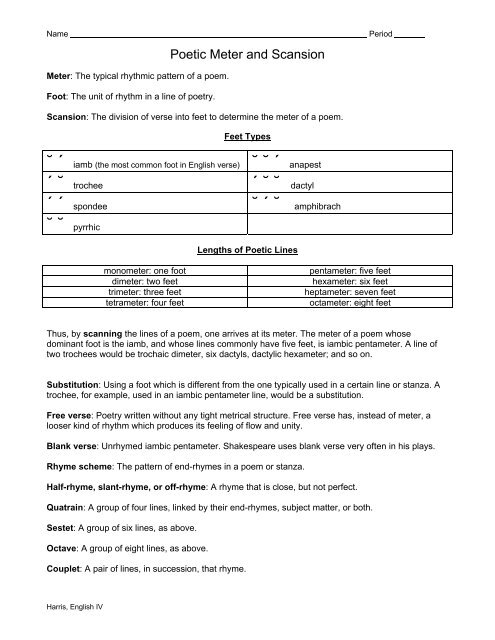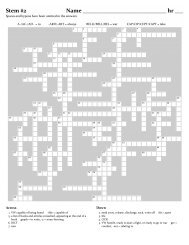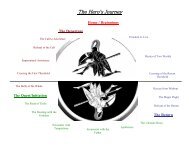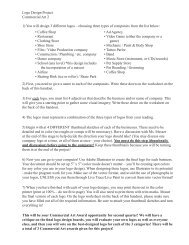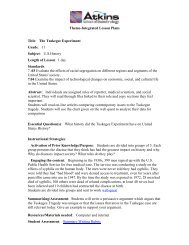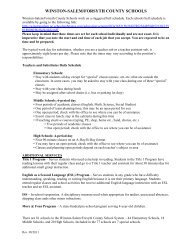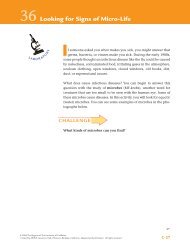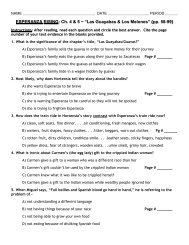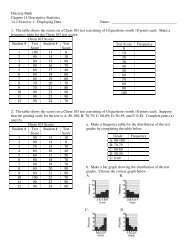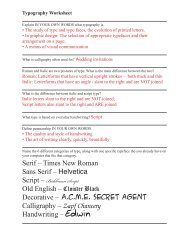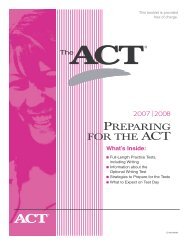´ ˘ trochee ´ ˘ ˘ dactyl ´ ´ spondee ˘ ˘ pyrrhic
´ ˘ trochee ´ ˘ ˘ dactyl ´ ´ spondee ˘ ˘ pyrrhic
´ ˘ trochee ´ ˘ ˘ dactyl ´ ´ spondee ˘ ˘ pyrrhic
Create successful ePaper yourself
Turn your PDF publications into a flip-book with our unique Google optimized e-Paper software.
Name Period<br />
Meter: The typical rhythmic pattern of a poem.<br />
Foot: The unit of rhythm in a line of poetry.<br />
Poetic Meter and Scansion<br />
Scansion: The division of verse into feet to determine the meter of a poem.<br />
Feet Types<br />
<strong>˘</strong> ΄ iamb (the most common foot in English verse) <strong>˘</strong> <strong>˘</strong> ΄ anapest<br />
΄ <strong>˘</strong> <strong>trochee</strong> ΄ <strong>˘</strong> <strong>˘</strong> <strong>dactyl</strong><br />
΄ ΄ <strong>spondee</strong> <strong>˘</strong> ΄ <strong>˘</strong> amphibrach<br />
<strong>˘</strong> <strong>˘</strong> <strong>pyrrhic</strong><br />
Lengths of Poetic Lines<br />
monometer: one foot pentameter: five feet<br />
dimeter: two feet hexameter: six feet<br />
trimeter: three feet heptameter: seven feet<br />
tetrameter: four feet octameter: eight feet<br />
Thus, by scanning the lines of a poem, one arrives at its meter. The meter of a poem whose<br />
dominant foot is the iamb, and whose lines commonly have five feet, is iambic pentameter. A line of<br />
two <strong>trochee</strong>s would be trochaic dimeter, six <strong>dactyl</strong>s, <strong>dactyl</strong>ic hexameter; and so on.<br />
Substitution: Using a foot which is different from the one typically used in a certain line or stanza. A<br />
<strong>trochee</strong>, for example, used in an iambic pentameter line, would be a substitution.<br />
Free verse: Poetry written without any tight metrical structure. Free verse has, instead of meter, a<br />
looser kind of rhythm which produces its feeling of flow and unity.<br />
Blank verse: Unrhymed iambic pentameter. Shakespeare uses blank verse very often in his plays.<br />
Rhyme scheme: The pattern of end-rhymes in a poem or stanza.<br />
Half-rhyme, slant-rhyme, or off-rhyme: A rhyme that is close, but not perfect.<br />
Quatrain: A group of four lines, linked by their end-rhymes, subject matter, or both.<br />
Sestet: A group of six lines, as above.<br />
Octave: A group of eight lines, as above.<br />
Couplet: A pair of lines, in succession, that rhyme.<br />
Harris, English IV
Name Period<br />
Stanza: A group of lines set off by themselves in a poem. Properly speaking, all stanzas in a poem<br />
have the same number of lines; if they don’t, they should be called irregular stanzas, sections, or even<br />
verse paragraphs.<br />
Sonnet: A fourteen-line, lyric poem with a single theme written in iambic pentameter. The sonnet was<br />
invented by Italian poet Francesco Petrarch. Sonnets follow definite forms. The form is determined by<br />
the type of sonnet.<br />
The Italian or Petrarchan sonnet consists of an octave followed by a sestet. The octave is almost<br />
always rhymed abbaabba; the sestet’s rhyme scheme is either cdecde, cdccdc, or cdedce. Often<br />
the octave states a problem, and the sestet resolves it.<br />
The Spenserian sonnet was invented by English poet Edmund Spenser. It consists of three<br />
quatrains followed by a rhyming couplet. The rhyme scheme is abab/bcbc/cdcd/ee.<br />
The English or Shakespearean sonnet has three quatrains followed by a rhyming couplet. The<br />
typical rhyme scheme is abab/cdcd/efef/gg. Usually the couplet comments epigrammatically on the<br />
problem/situation presented in the three quatrains.<br />
In a sonnet sequence, sonnets are linked by theme or person addressed.<br />
Adapted from: C. Hugh Holman, A Handbook to Literature, Lynn Altenbernd and Leslie L. Lewis, A Handbook for the Study<br />
of Poetry. Source: http://www.writing.upenn.edu/~afilreis/88/sonnet.html<br />
Source: Prentice Hall Literature: The British Tradition – unit 2<br />
Harris, English IV


